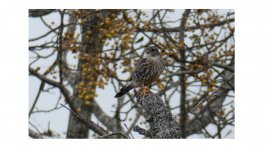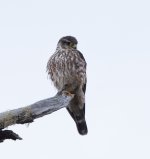-
Welcome to BirdForum, the internet's largest birding community with thousands of members from all over the world. The forums are dedicated to wild birds, birding, binoculars and equipment and all that goes with it.
Please register for an account to take part in the discussions in the forum, post your pictures in the gallery and more.
You are using an out of date browser. It may not display this or other websites correctly.
You should upgrade or use an alternative browser.
You should upgrade or use an alternative browser.
Merlin (1 Viewer)
- Thread starter knnthdhrvy
- Start date
More options
Who Replied?
Yes, a Merlin.
Rotherbirder
Well-known member

Mission accomplished Ken; fine image too.
RB
RB
knnthdhrvy
Ken Harvey
Thanks all. I was pretty sure, but I've been pretty sure before and been wrong. Thanks for your help.
Earnest lad
Well-known member
Please does anyone know if the Merlins of North America differ at all in any way from the ones seen in UK and mainland Europe?
Please does anyone know if the Merlins of North America differ at all in any way from the ones seen in UK and mainland Europe?
These short answer is, yes: there are 3 North American subspecies with an additional 6 in other parts of the world. The OP’s bird belongs to the Taiga subspecies.
Here’s the complete rundown of all 9, excerpted from BNA-online—
"Subspecies
Polytypic, 9 subspecies worldwide, 3 in North American. Details in Temple (Temple 1972b), Ferguson-Lees and Christi (2001), and Wheeler (Wheeler 2003b, Wheeler 2003b).
In N. America:
A) Black Merlin (F. c. suckleyi) breeds in humid forests of Pacific northwest (Washington, British Columbia, and se. Alaska); generally nonmigratory but some individuals move as far south as s. California and New Mexico. Appears very dark, particularly at a distance. Adult male: dark bluish gray crown, cheeks, auriculars, back, scapulars and rump; breast rufous-tawny, belly whitish, leg feathers rufous; underwings generally dark but small amount of pale spotting variously present; tail generally all-black dorsally, 1-2 rows of partial white bands ventrally. Adult female: dark brown crown, cheeks, auriculars, nape, and back; ventral surface has thick dark streaking over whitish or tawny base; upper tail uniformly dark brown with wide black subterminal band; 1-2 pale bands on ventral side of dark tail. Juvenile: very similar to female.
B) “Boreal” or “Taiga” Merlin (F. c. columbarius) breeds from Newfoundland to w. Alaska south into the n. US (Maine and n. Vermont, New Hampshire, and NY; n. Great Lakes states, and w. mountain states). Highly migratory; winters as far south as n. Peru, as far north as n. US and s. Canada; most winter south of US, with West Indies a center of winter abundance (see Migration). Overall grayer than suckleyi, and paler on breast and belly. Adult male: cere and orbital skin medium yellow; faint dark malar mark; pale supercilium and cheeks; medium bluish gray upperparts; breast and belly streaked with brown, barred on the flanks; lightly streaked rufous-tawny leg feathers; tail black with 2-3 narrow bluish-gray bands; white or tawny underparts, moderately streaked with brown; moderately dark underwings, spotted white (about 50% of surface). Adult female: overall browner than male, e.g., medium brown crown and auriculars, back, wings; belly uniformly tawny or white with pronounced brown streaking; dark brown primaries typically with pale tawny spots; upper tail variously banded (2-3) or not, depending on individual; ventral tail 3-4 pale bands when tail is fanned. Juvenile: much like adult female but juvenile males separable by smaller size and grayish dorsal tail bands; juvenile females separable only in late summer/fall by lack of molt. For details see Wheeler (2003 Wheeler 2003b, Wheeler 2003b).
C) Prairie Merlin (F. c. richardsonii) breeds in s.-central Canada and n. U.S. Prairie states, and migrates into s. United States and Central America. Some individuals winter in breeding range, especially in prairie cities (e.g., Saskatoon, Edmonton, Billings, Grand Forks) where prey are plentiful. Distinctly paler than other N. American subspecies; black feather shafts obvious, especially on upperwing. Large pale spots on underwings and on dorsal outer surface of all primaries. Distinct wide white bands on tail, with terminal band broader. Adult male (from Wheeler 2003b): thin white supercilium, pale bluish-gray crown lightly streaked with white; white chin; pale bluish-gray back, scapulars, rump; lightly streaked (brownish) white underparts; pale tawny leg feathers; pale underwings: white spotting/barring covers >50% of surface of each remix; black tail has 3-4 broad white bands. Adult female: thin white supercilium; white underparts lightly streaked with brown; upperparts pale brown, edged (and often spotted) pale tawny/white; broad white bands on tail; underwings pale, spotting/barring as in male; pointed wingtips. Juvenile: nearly identical to adult female in all aspects.
In Eurasia, 6 additional subspecies (based on Ferguson-Lees and Christi 2001, Wheeler 2003b): (1) F. c. subaesalon, Iceland breeder, winters w. Iceland and in Ireland and w. UK, occasionally eastward to Norway and w. Europe; (2) F. c. aesalon, breeds on Faeroe Is. and from n. Europe to w. Siberia, winters from Mediterranean region eastward to Iran; Similar in color to subaesalon, but smaller. (3) F. c. pallidus breeds w. Siberia and Kazakhstan, winters from e. Turkey to nw. India. Palest and largest of Eurasian races, similar to richardsonii . (4) F. c. insignis breeds central and e. Siberia, winters n. India, Korea, and Japan. Pale plumaged but darker than pallidus . (5) F. c. pacificus, breeds e. Siberia, winters from n. China to Japan. Darker than previous 2 Siberian races; most similar to suckleyi . (6) F. c. lymani breeds in mountains of central Asia, winters in China. Similar to insignis but longer wings."
Last edited:
Worth looking at the opus entry too:
https://www.birdforum.net/opus/Merlin
There you can see that people have suggested splitting the American from the eurasian forms.
https://www.birdforum.net/opus/Merlin
There you can see that people have suggested splitting the American from the eurasian forms.
Earnest lad
Well-known member
Dear fugi
That information is not only very interesting but very helpful too. Thank you so much.
I am only guessing but would I be right to imagine the bird in the photo posted above would be F. f. c. richardsonii. I do think it looks a bit different somehow to the birds that we can see in UK.
In the UK the Merlin is a fairly shy bird. Is this the same in regard to Merlins seen in North America please?
That information is not only very interesting but very helpful too. Thank you so much.
I am only guessing but would I be right to imagine the bird in the photo posted above would be F. f. c. richardsonii. I do think it looks a bit different somehow to the birds that we can see in UK.
In the UK the Merlin is a fairly shy bird. Is this the same in regard to Merlins seen in North America please?
Nutcracker
Stop Brexit!
Much less shy - in N America it hasn't been subjected to the intense illegal persecution that it suffers on UK grouse moors :-C :storm:In the UK the Merlin is a fairly shy bird. Is this the same in regard to Merlins seen in North America please?
In some areas (e.g. Calgary) it has adapted to urban nesting.
Andy Adcock
Worst person on Birdforum

Nutcracker
Stop Brexit!
I'd think most likely nominate F. c. columbarius (breeds subarctic areas from Alaska to Newfoundland); as far as I know, that's the longest distance migrant of the New World subspecies.Which race is seen in Central America?
Here's one we had in Costa Rica.
RafaelMatias
Unknown member

as far as I know, that's the longest distance migrant of the New World subspecies.
Taiga Merlin has been recorded at least 5 times in the WP: https://birdingfrontiers.wordpress.com/2010/08/11/taiga-merlin/
Andy Adcock
Worst person on Birdforum

Cheers Nutty.
Earnest lad
Well-known member
Does anyone know if the Merlin is more common in North America than it is in the UK?
Nutcracker
Stop Brexit!
Depends on where you are - North America's a big place! And even in Britain, there's big variation in how easy it is to get Merlin. Though as mentioned, the species is persecuted illegally in Britain, so the population is lower than it should be.Does anyone know if the Merlin is more common in North America than it is in the UK?
Andy Adcock
Worst person on Birdforum

Does anyone know if the Merlin is more common in North America than it is in the UK?
I would imagine that with a much larger, available habitat than the UK, there will be more birds but the density may be the same?
Earnest lad
Well-known member
Thank you ... I wonder if the Merlin in North America is a bird of the same type habitat as it is in UK?
Nutcracker
Stop Brexit!
Largely yes, but also uniquely urban-adapted in prairie towns in central Canada :t:Thank you ... I wonder if the Merlin in North America is a bird of the same type habitat as it is in UK?
Earnest lad
Well-known member
Dear Nutcracker
That's most interesting - thank you. To think that in those towns Merlins might be seen in an urban setting just like for example how in the UK we can sometimes see Sparrowhawks or Kestrels in that kind of habitat.
It just goes to show that were persecution to cease how much birds (and other creatures) would I imagine, gradually become much more approachable & trusting.
That's most interesting - thank you. To think that in those towns Merlins might be seen in an urban setting just like for example how in the UK we can sometimes see Sparrowhawks or Kestrels in that kind of habitat.
It just goes to show that were persecution to cease how much birds (and other creatures) would I imagine, gradually become much more approachable & trusting.
Last edited:
Users who are viewing this thread
Total: 2 (members: 0, guests: 2)






